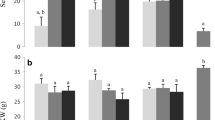Abstract
Barley biotypes from the world collection differ in their storage protein content even till 200 %. This is the first report including results of the research, in which the structure of grains containing different amount of protein was tested to explain this difference. The endosperm was investigated using scanning electron microscopy. The structure of the aleurone layer, storing large quantities of protein, did not differ between the high- and low-protein forms of barley. It has been proven that the large quantities of kernel protein may be stored in some cells of the zone adjacent to the aleurone layer, defined as the subaleurone cells. It has been shown that morphologically uniform kernels of the same plant and even of the same ear can vary greatly with respect to the number of these subaleurone cells. The purpose of the study was an examination of variation in protein structure in single kernels of a fodder, a brewery and in an extra high-protein form of barley as well. Moreover the studies were aimed to detect qualitative differences in the subaleurone protein. Application of mass spectrometry made possible the identification of several kinds of proteins which were present in subaleurne layer of kernels. In the granule-bound protein fraction isolated from the subaleurone type kernels, a much stronger representation of some protein was found, with the molecular mass between 29 and 45 kDa, in comparison with the low-protein kernels. It is supposed, that these protein are isoforms of z-type serpin and B3-hordein.
Similar content being viewed by others
Abbreviations
- EDTA:
-
ethylenedinitrilotetraacetic acid disodium salt
- MALDI:
-
matrix-assisted laser-desorption ionisation
- PMSF:
-
phenylmethylsulfonyl fluoride
References
Bak-Jensen K., Laugesen S., Roepstorff P., Svensson B. 2004. Proteome analysis of barley seeds: Identification of major proteins from two-dimensional gels (pI 4-7). Proteomics, 4: 728–742.
Brej S. 1973. Zawarto białka w ziarniakach miesza — ców F2 pszenicy zwyczajnej formy jarej. Hod. Ro l. Aklimat., 17/6: 419–423.
Dahl S. W., Rasmussen S. K., Hejgaard J, 1996. Heterologous expression of three plant serpins with distinct inhibitory specificities. J. Biol. Chem. 271: 25083–25088.
Finnie C, Maeda K., Østergaard O., Bak-Jensen K., Larsen J., Svennsson B. 2004. Aspects of the barley seed proteome during development and germination. Biochem. Soc. Trans. 32: 517–519.
Finnie C, Svennsson B. 2003. Feasibility of a tissue-specific approach to barley proteome analysis: aleurone layer, endosperm, embryo and single seeds. J. Cereal Sci. 38: 217–227.
Gaines R., Bechtel D., Pomeranz Y., 1983. Endosperm structural and biochemical differences between the high-protein amphiploid and its progenitors. Cereal Chem., 62: 25–31.
Jongsma M. A., Bolter C. 1997. The adaptation of insects to plant protease inhibitors. J. Insect. Physiol. 885–895.
Kaczmarek J. 1977. Zawarto białka w ziarnie linii wsobnych yta. Biul. IHAR., 131: 69–80.
Kaufmann R., Kirsch D., Spengler B. 1994. Sequencing of peptides in a time-of-flight mass spectrometer — Evaluation of postsource decay following matrix-assisted laser-desorption ionisation (MALDI). Int. J. Mass Spectrom. Ion Proc., 131: 355–385.
Kirkman M.A., Shewry P.R. Miflin B.J. 1982. The effect of nitrogen nutrition on the lysine content and protein composition of barley seeds. J. Sci. Food Agric. 33: 115–127.
Kosina R. 1988. Relationship between xylem bundle and subaleurone endosperm layer in wheat tetraploids caryopses. Hod. Ro l. Aklim. Nas. 32/1–2: 235–237.
Laemmli U.K. 1970. Cleavage of structural proteins during the assembly of the head of bacteriophage T4. Nature 227: 680–685.
Macewicz J. 1992. Subaleurone tissue and high protein content in barley cultivars. Hod. Ro l. Aklim. 36/1–2: 47–59.
Macewicz J. 1995. Odziedziczalno zawarto ci białka w selekcji wykorzystuj cej zró nicowanie budowy anatomicznej ziarniaków pojedynczej ro liny j czmienia. Hod. Ro l. Aklim. 39/6 3–26.
Macewicz J. 2000. Differential occurrence of protein subaleurone layer in seeds of barley cultivars for brewery industry. Biul. IHAR, 216: 237–242.
Østergaard H., Rasmussen S.K., Roberts T.H., Hejgaard J. 2000. Inhibitory Serpins from Wheat Grain with Reactive Centers Resembling Glutamine-rich Repeats of Prolamin Storage Proteins. Cloning and characterization of five major molecular forms. J. Biol. Chem., 275: 33272–33279.
Østergaard O., Finnie C., Laugesen S., Roepstorff P., Svensson B. 2004. Proteome analysis of barley seeds: Identification of major proteins from two-dimensional gels (pI 4-7). Proteomics, 4: 2437–2447.
Author information
Authors and Affiliations
Corresponding author
Rights and permissions
About this article
Cite this article
Macewicz, J., Orzechowski, S., Dobrzy ska, U. et al. Is quantity of protein in barley forms determined by proteins localized in the subaleurone layer?. Acta Physiol Plant 28, 409–416 (2006). https://doi.org/10.1007/BF02706623
Received:
Accepted:
Issue Date:
DOI: https://doi.org/10.1007/BF02706623




